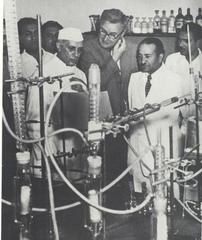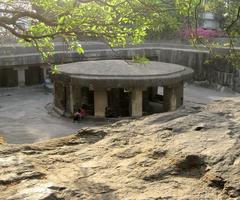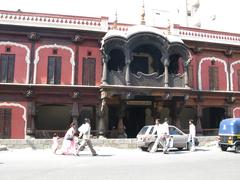Mahatma Phule Vastu Sangrahalaya Visiting Hours, Tickets, and Historical Insights
Date: 23/07/2024
Introduction
Mahatma Phule Vastu Sangrahalaya, located in the bustling city of Pune, India, is a prominent cultural institution that offers a deep dive into the country’s rich historical and cultural heritage. Originally known as the Poona Museum, it was established in 1890 by the British colonial government to commemorate the visit of the Prince of Wales, later King Edward VII. The museum was initially housed in the bungalow of Sir David Sassoon, a well-known Jewish merchant and philanthropist. Over the years, the museum has evolved into a repository of over 17,000 objects, encompassing various categories such as archaeology, arms and armor, decorative arts, and natural history (Maharashtra Tourism).
The architectural significance of the museum is noteworthy, featuring an Indo-Saracenic style that blends Indian and Gothic revival elements. This fusion reflects the grandeur and cultural amalgamation of the British Raj era. In 1968, the museum was renamed Mahatma Phule Vastu Sangrahalaya in honor of Jyotirao Phule, a social reformer who championed the cause of marginalized communities in Maharashtra. Phule’s contributions to education, women’s rights, and the eradication of caste discrimination are monumental, making the renaming a fitting tribute to his legacy (Cultural India).
This comprehensive guide aims to provide visitors with all the essential information they need to make the most of their visit to Mahatma Phule Vastu Sangrahalaya. From its rich history and architectural marvels to its extensive collections and educational initiatives, this guide will cover everything you need to know, including visiting hours, ticket prices, travel tips, nearby attractions, and more.
Table of Contents
- Introduction
- History of Mahatma Phule Vastu Sangrahalaya
- Collection and Exhibits
- Role in Education and Research
- Visitor Information
- Travel Tips
- Accessibility
- Conservation Efforts
- Community Engagement
- Future Plans
- Conclusion
- FAQs
History of Mahatma Phule Vastu Sangrahalaya
Establishment and Early Years
Mahatma Phule Vastu Sangrahalaya, originally known as the Poona Museum, was established in 1890. The museum was founded by the British colonial government to commemorate the visit of the Prince of Wales, later King Edward VII, to India. The foundation stone was laid by Sir James Fergusson, the then Governor of Bombay. The museum was initially housed in the bungalow of Sir David Sassoon, a prominent Jewish merchant and philanthropist. The building itself is an architectural marvel, blending Gothic and Moorish styles, which was a common trend in colonial architecture during that period.
Renaming and Dedication
In 1968, the museum was renamed Mahatma Phule Vastu Sangrahalaya in honor of Jyotirao Phule, a social reformer and activist who worked tirelessly for the upliftment of the marginalized communities in Maharashtra. Phule’s contributions to education, women’s rights, and the eradication of caste discrimination were monumental, making the renaming a tribute to his enduring legacy.
Architectural Significance
The museum building is a fine example of Indo-Saracenic architecture, a style that combines elements of Indian and Gothic revival architecture. The structure features intricate stone carvings, pointed arches, and expansive verandas. The design was intended to reflect the grandeur and cultural amalgamation of the British Raj era. The building’s aesthetic appeal is enhanced by its lush green surroundings, making it a serene spot in the bustling city of Pune.
Collection and Exhibits
The museum’s collection began with a modest assortment of artifacts donated by local citizens and British officials. Over the years, it has grown to include over 17,000 objects, encompassing a wide range of categories such as archaeology, arms and armor, decorative arts, and natural history. Notable exhibits include:
Archaeological Artifacts
The museum houses a significant collection of artifacts from the Indus Valley Civilization, including pottery, tools, and seals. These items provide invaluable insights into one of the world’s oldest urban cultures.
Maratha History
The museum has a dedicated section on the Maratha Empire, featuring weapons, coins, and personal belongings of Maratha rulers. This collection highlights the military prowess and cultural richness of the Maratha period.
Decorative Arts
The museum’s decorative arts section includes a variety of items such as textiles, jewelry, and metalwork. These artifacts showcase the craftsmanship and artistic traditions of different regions of India.
Natural History
The natural history section features a diverse collection of specimens, including taxidermy animals, botanical samples, and geological specimens. This section aims to educate visitors about the rich biodiversity of India.
Role in Education and Research
Mahatma Phule Vastu Sangrahalaya has played a crucial role in the field of education and research. The museum conducts regular workshops, lectures, and educational programs aimed at students, researchers, and the general public. These initiatives are designed to foster a deeper understanding of India’s cultural heritage and promote the preservation of historical artifacts.
The museum also collaborates with various academic institutions and research organizations to facilitate scholarly research. Its extensive collection serves as a valuable resource for historians, archaeologists, and art historians. The museum’s library, which houses a vast collection of books, manuscripts, and journals, further supports research activities.
Visitor Information
Visiting Hours
Mahatma Phule Vastu Sangrahalaya is open from 10:00 AM to 5:00 PM, Tuesday to Sunday. The museum is closed on Mondays and public holidays.
Ticket Prices
General admission tickets are priced at INR 50 for adults and INR 25 for children. Special discounts are available for students and senior citizens.
Special Guidelines
Visitors are advised to maintain silence and not touch the exhibits. Photography is allowed in certain sections with prior permission.
Travel Tips
Best Times to Visit
The museum is less crowded in the mornings and on weekdays. Visiting during these times can provide a more relaxed experience.
How to Get There
The museum is located in the heart of Pune and can be easily accessed by public transport, taxis, or private vehicles. Parking is available on-site.
Nearby Attractions
While in Pune, visitors can also explore other historical sites such as Shaniwar Wada, Aga Khan Palace, and Pataleshwar Cave Temple.
Accessibility
The museum is committed to being accessible to all visitors. Ramps and elevators are available for wheelchair users. Special guided tours can be arranged for visitors with disabilities upon request.
Conservation Efforts
Preserving the museum’s extensive collection is a continuous challenge. The museum has implemented several conservation measures to protect its artifacts from environmental damage and deterioration. These measures include climate control systems, regular maintenance, and the use of archival-quality storage materials. The museum also employs a team of conservators who specialize in the restoration and preservation of different types of artifacts.
In recent years, the museum has undertaken several digitization projects to create digital records of its collection. These digital records not only help in the preservation of artifacts but also make the collection more accessible to researchers and the public. The museum’s website features an online catalog of its collection, allowing users to explore the artifacts from anywhere in the world.
Community Engagement
Mahatma Phule Vastu Sangrahalaya is deeply committed to community engagement. The museum organizes various cultural events, exhibitions, and outreach programs to engage with the local community and promote cultural awareness. These events often feature traditional music and dance performances, art exhibitions, and craft workshops, providing a platform for local artists and artisans to showcase their talents.
The museum also collaborates with schools and educational institutions to offer guided tours and educational programs for students. These programs are designed to make learning about history and culture an interactive and enjoyable experience for young learners.
Future Plans
Looking ahead, Mahatma Phule Vastu Sangrahalaya aims to continue its mission of preserving and promoting India’s cultural heritage. The museum plans to expand its collection and enhance its exhibits with the help of modern technology. Plans are also underway to renovate and upgrade the museum’s facilities to provide a better experience for visitors.
The museum is also exploring partnerships with international museums and cultural institutions to facilitate cultural exchange and collaboration. These partnerships will help bring global perspectives to the museum’s exhibits and programs, enriching the cultural experience for visitors.
Conclusion
Mahatma Phule Vastu Sangrahalaya stands as a testament to India’s rich cultural heritage and history. Its extensive collection, educational initiatives, and community engagement efforts make it a vital cultural institution in Pune. For visitors, the museum offers a unique opportunity to explore India’s past and gain a deeper appreciation for its diverse cultural traditions.
FAQs
What are the visiting hours for Mahatma Phule Vastu Sangrahalaya? The museum is open from 10:00 AM to 5:00 PM, Tuesday to Sunday. It is closed on Mondays and public holidays.
How much are the tickets for Mahatma Phule Vastu Sangrahalaya? General admission tickets are priced at INR 50 for adults and INR 25 for children. Discounts are available for students and senior citizens.
Is the museum accessible for visitors with disabilities? Yes, the museum is equipped with ramps and elevators for wheelchair access. Special guided tours can be arranged upon request.
What are some nearby attractions to Mahatma Phule Vastu Sangrahalaya? Nearby attractions include Shaniwar Wada, Aga Khan Palace, and Pataleshwar Cave Temple.
Call to Action
Stay updated with more cultural insights and travel tips by following us on social media or downloading our mobile app Audiala. Don’t forget to check out other related posts on our website.




